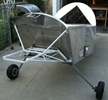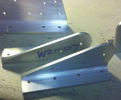


random user submitted photo
Fuel tank embedded fittings - repairing small leaks
Forum rules
Lessons-learned submissions follow a standardized format designed to identify the issue, draw out the relevant factors and present useful guidance to others facing a similar situation. The submitter answers the following 5 questions:
1) What went wrong (or right), and why?
2) What were the shortcomings, and why did they exist?
3) What actions were taken to fix the problem?
4) What preventive actions should be taken into account for future efforts?
5) What overall recommendations should be made for future projects?
The length of the write-up and amount of detail presented are left up to each individual. Some lessons learned can be perfectly conveyed in a few simple sentences, while others will require much more. The goal is to be as clear and succinct as possible, not to generate literary masterpieces!
All posts submitted to this forum are held in a review queue for approval by a moderator. Information in the posts will be reviewed, vetted, and modified as needed before going public. Additionally, any replies that are submitted would also be reviewed to ensure they add value and remain on topic. This will avoid normal threat drift of general discussions.
Lessons-learned submissions follow a standardized format designed to identify the issue, draw out the relevant factors and present useful guidance to others facing a similar situation. The submitter answers the following 5 questions:
1) What went wrong (or right), and why?
2) What were the shortcomings, and why did they exist?
3) What actions were taken to fix the problem?
4) What preventive actions should be taken into account for future efforts?
5) What overall recommendations should be made for future projects?
The length of the write-up and amount of detail presented are left up to each individual. Some lessons learned can be perfectly conveyed in a few simple sentences, while others will require much more. The goal is to be as clear and succinct as possible, not to generate literary masterpieces!
All posts submitted to this forum are held in a review queue for approval by a moderator. Information in the posts will be reviewed, vetted, and modified as needed before going public. Additionally, any replies that are submitted would also be reviewed to ensure they add value and remain on topic. This will avoid normal threat drift of general discussions.
3 posts
• Page 1 of 1
Fuel tank embedded fittings - repairing small leaks
After 15 years in operation, and having removed and reinstalled the fuel line between the tank and the firewall on multiple occasions, the tank main outlet embedded fitting began to leak fuel around its perimeter. The leak never became large enough to drip fuel to the floor but that may be because the fuel was wiped away before it could form droplets. The tank on my Sonex is one of the original black polyethelene tanks but the process described below should be applicable to the later versions of the tank as well. As of this writing, using only 100LL fuel and living in California where the OAT has varied from 100 degrees F. to 40 degrees F., the process has been successful in stopping the leak for a period of 6 months and 50 flight hours.
1. Drain the tank of all fuel. It's probably best to let the tank sit for a day or two to allow fuel around the fitting
to evaporate.
2. Sand the tank around the pipe entrance with 220 grit emory cloth and far enough to contain a 1 1/2" o.d.
washer. Clean the sanded area with lacquer thinner.
3. Prepare a 1 1/2" o.d. washer made of polypropylene (pp #5) plastic. A lid from a food container (potato
salad or ? ) can be used for this purpose (t = 0.018"). Sand the side of the washer to face the tank to
roughen the surface and then clean with lacquer thinner. Leave the paper label on the outside of the washer.
If the pipe is not to be removed (recommended), cut a slit in the washer to allow for installation. See photo
below.
4. Using the Loctite Plastics Bonding System (SKU 7934082565, see photo below), apply the "activator" to the
tank, including the crack around the embedded fitting, and to the side of the washer to face the tank. The
activator is what allows the glue to do its job so be generous with its application. An artist brush works well
to apply the activator.
5. Apply the Loctite glue to all surfaces where the activator was applied. Again, an artist brush works well to
apply the glue. Press the washer in place on the tank being careful to apply pressure at all locations to
achieve a good bond and seal.
6. After the glue has fully dried, apply a coating of J-B Weld around the connection as shown in the photo
below.
7. After another day or two, add a couple of gallons of fuel to the tank and check for leaks. Hopefully, none
found then or in the future.
1. Drain the tank of all fuel. It's probably best to let the tank sit for a day or two to allow fuel around the fitting
to evaporate.
2. Sand the tank around the pipe entrance with 220 grit emory cloth and far enough to contain a 1 1/2" o.d.
washer. Clean the sanded area with lacquer thinner.
3. Prepare a 1 1/2" o.d. washer made of polypropylene (pp #5) plastic. A lid from a food container (potato
salad or ? ) can be used for this purpose (t = 0.018"). Sand the side of the washer to face the tank to
roughen the surface and then clean with lacquer thinner. Leave the paper label on the outside of the washer.
If the pipe is not to be removed (recommended), cut a slit in the washer to allow for installation. See photo
below.
4. Using the Loctite Plastics Bonding System (SKU 7934082565, see photo below), apply the "activator" to the
tank, including the crack around the embedded fitting, and to the side of the washer to face the tank. The
activator is what allows the glue to do its job so be generous with its application. An artist brush works well
to apply the activator.
5. Apply the Loctite glue to all surfaces where the activator was applied. Again, an artist brush works well to
apply the glue. Press the washer in place on the tank being careful to apply pressure at all locations to
achieve a good bond and seal.
6. After the glue has fully dried, apply a coating of J-B Weld around the connection as shown in the photo
below.
7. After another day or two, add a couple of gallons of fuel to the tank and check for leaks. Hopefully, none
found then or in the future.
- builderflyer
- Posts: 422
- Joined: Sat Jul 09, 2016 12:13 pm
Re: Fuel tank embedded fittings - repairing small leaks
This is a great technique to fix minor leaks, especially on tanks that are already installed and in service. It's also much less invasive and a whole lot less work than installing an oops fitting. Definitely try this first!
Jeff
Jeff
- sonex1374
- Posts: 605
- Joined: Thu Mar 27, 2014 1:02 am
Re: Fuel tank embedded fittings - repairing small leaks
Hi Art, all,
Yes this is the Locktite plastics bonding I've talked about a few times. Glad it worked for you. On our application we used a thicker plastic washer then a metal washer, with enough thickness to have the brass fitting snug up against the washers. Tighten snug, and then a little glue will ooze out. Let sit to harden. The small glue tube looks smells just like super glue gel. No leaks on our unused fitting for a few years.
Waiex N143NM
Michael
Yes this is the Locktite plastics bonding I've talked about a few times. Glad it worked for you. On our application we used a thicker plastic washer then a metal washer, with enough thickness to have the brass fitting snug up against the washers. Tighten snug, and then a little glue will ooze out. Let sit to harden. The small glue tube looks smells just like super glue gel. No leaks on our unused fitting for a few years.
Waiex N143NM
Michael
- WaiexN143NM
- Posts: 1159
- Joined: Mon Sep 15, 2014 1:04 am
- Location: SF CA, Tucson AZ, palm springs CA
3 posts
• Page 1 of 1
Who is online
Users browsing this forum: No registered users and 2 guests







